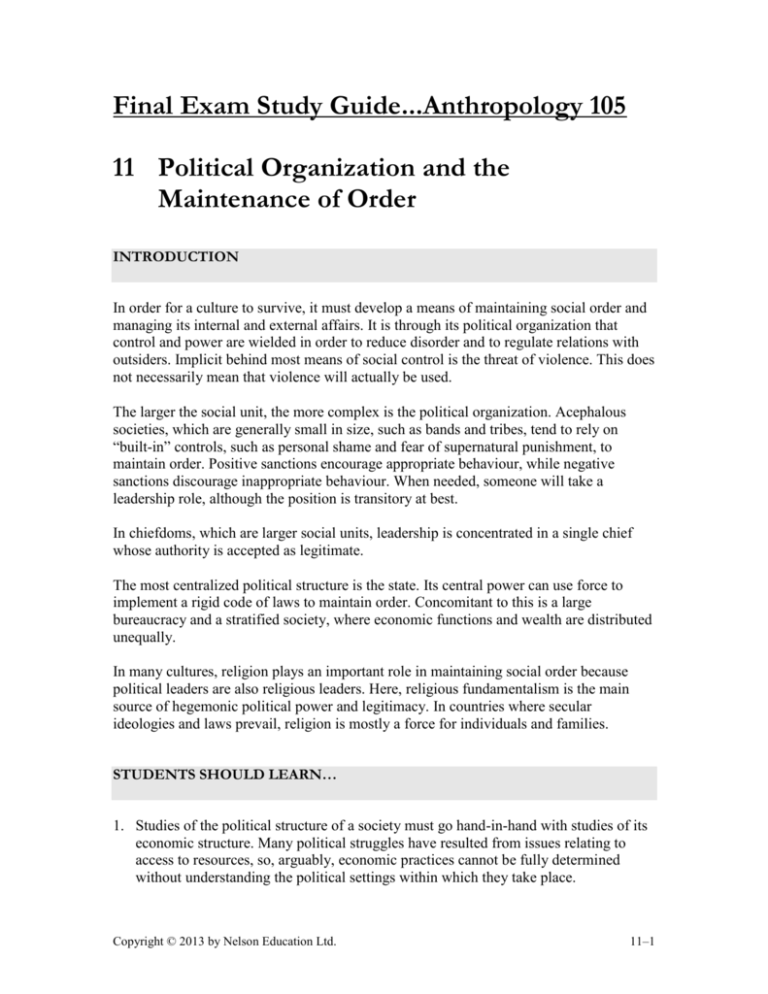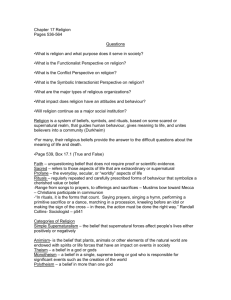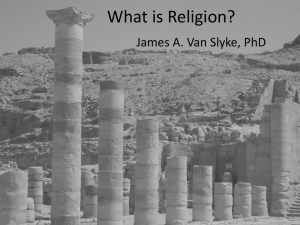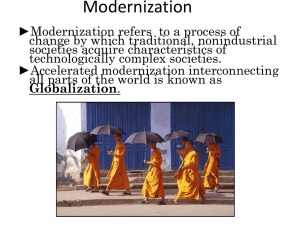Final Exam Study guide
advertisement

Final Exam Study Guide...Anthropology 105 11 Political Organization and the Maintenance of Order INTRODUCTION In order for a culture to survive, it must develop a means of maintaining social order and managing its internal and external affairs. It is through its political organization that control and power are wielded in order to reduce disorder and to regulate relations with outsiders. Implicit behind most means of social control is the threat of violence. This does not necessarily mean that violence will actually be used. The larger the social unit, the more complex is the political organization. Acephalous societies, which are generally small in size, such as bands and tribes, tend to rely on “built-in” controls, such as personal shame and fear of supernatural punishment, to maintain order. Positive sanctions encourage appropriate behaviour, while negative sanctions discourage inappropriate behaviour. When needed, someone will take a leadership role, although the position is transitory at best. In chiefdoms, which are larger social units, leadership is concentrated in a single chief whose authority is accepted as legitimate. The most centralized political structure is the state. Its central power can use force to implement a rigid code of laws to maintain order. Concomitant to this is a large bureaucracy and a stratified society, where economic functions and wealth are distributed unequally. In many cultures, religion plays an important role in maintaining social order because political leaders are also religious leaders. Here, religious fundamentalism is the main source of hegemonic political power and legitimacy. In countries where secular ideologies and laws prevail, religion is mostly a force for individuals and families. STUDENTS SHOULD LEARN… 1. Studies of the political structure of a society must go hand-in-hand with studies of its economic structure. Many political struggles have resulted from issues relating to access to resources, so, arguably, economic practices cannot be fully determined without understanding the political settings within which they take place. Copyright © 2013 by Nelson Education Ltd. 11–1 2. Any study of political systems must be global and comparative so that differences in power and authority can be understood. Students should be able to: Identify the four major kinds of political organization. [Remember] Explain how internal political and social control is maintained in different political systems. [Understand] Describe how external affairs are conducted in different political systems. [Remember] Explain how conflicts are resolved. [Understand] Explain the functions of law. [Understand] Recognize the impact of religion on social control. [Remember] Discuss Canada’s role as an international peacekeeper. [Understand] KEY TERMS AND CONCEPTS 1. Band—A small group of related households occupying a particular region who gather periodically but do not yield their sovereignty to the larger collective. (page 244) 2. Consensus—A general agreement among adult members of a group. (page 245) 3. Tribe—A group of nominally independent communities occupying a specific region and sharing a common language and culture integrated by some unifying factor. (page 246) 4. Segmentary lineage system—A form of political organization in which a large group is broken up into clans, which are further divided into lineages. (page 247) 5. Chiefdom—A regional polity in which two or more local groups are organized under a single chief, who is at the head of a ranked hierarchy of people. (page 249) 6. State—In anthropology, a centralized political system with the power to coerce. (page 250) 11–2 Copyright © 2013 by Nelson Education Ltd. 7. Nation—Communities of people who see themselves as “one people” on the basis of common ancestry, history, society, institutions, ideology, language, territory, and (often) religion. (page 250) 8. Cultural control—Control through beliefs and values deeply internalized in the minds of individuals. (page 254) 9. Social control—Control over groups through coercion and sanctions. (page 254) 10. Sanctions—Externalized social controls designed to encourage conformity to social norms. (page 254) 11. Law—Formal negative sanctions. (page 255) 12. Negotiation—The use of direct argument and compromise by the parties to a dispute to arrive voluntarily at a mutually satisfactory agreement. (page 261) 13. Mediation—Settlement of a dispute through negotiation assisted by an unbiased third party. (page 261) 14. Adjudication—Mediation with an unbiased third party making the ultimate decision. (page 261) 15. World views—The conceptions, explicit and implicit, an individual or a group has of the limits and workings of its world. (page 264) 16. Naturalistic world view—The belief that humans are merely one part of the natural world. (page 265) 17. Exploitative world view—The belief that nature exists for humans to dominate and exploit. (page 265) 18. Structural violence—The widespread practice in many societies of inflicting harm on subordinate sectors of society by indirect means—such as poorer housing, schooling, or health care—rather than through the direct exercise of force and coercion. (page 266) Essay questions for final... Copyright © 2013 by Nelson Education Ltd. 11–3 12 Religion and the Supernatural INTRODUCTION All cultures have religion. The beliefs and rituals practised by cultures serve to maintain social order. This chapter explores the different forms of religions and the supernatural beings posited by them. The relationship between magic, science, and religion is considered. Religion is a dynamic system within a culture and evolves to meet the needs of the people. Religion is a symbolic practice that maintains the world view of a culture. That is, a religion uses metaphors derived from the structure of the society in which it is found as a model of the structure of the universe. Religion is a social experience by virtue of the ritual practices and pilgrimages undertaken in its name. Religion engages people in a collective experience. STUDENTS SHOULD LEARN… 1. Despite there being a challenge in determining an all-inclusive definition for religion, anthropologists recognize the necessity for identifying the role religion plays in a culture. 2. All religions posit supernatural beings or powers and use specific individuals to deal with them and perform the necessary rituals. 3. Cultures rationalize their religious systems through the use of myths and storytelling. It is not coincidental that the myths are consistent with the worldview expounded by a culture group. 4. Religion serves to reduce anxiety by providing an explanation for the unknown, and for teaching moral order to the next generation. Religion serves as a mechanism of social control by establishing appropriate behaviours, and by punishing those who have transgressed them. 5. Religion is a convenient way of transferring the burden of decision-making from individuals to supernatural powers. 11–4 Copyright © 2013 by Nelson Education Ltd. Students should be able to: Explain why religion is a universal system of culture. [Understand] Identify and discuss the various forms of religious belief. [Understand] Define myth and explain its roles in religious systems. [Remember/Understand] Identify the different types of ritual and discuss the roles that ritual plays in society. [Remember] Compare and contrast the relationship between religion, magic, and witchcraft. [Analyze] Identify and discuss the functions of religion. [Remember/Understand] Explain the reasons for revitalization movements. [Understand] KEY TERMS AND CONCEPTS 1. Religion—A set of rituals, rationalized by myth, that mobilizes supernatural powers to achieve or prevent transformations of state in people and nature. (page 274) 2. Polytheism—Belief in several gods and/or goddesses (as contrasted with monotheism—belief in one god). (page 278) 3. Pantheon—A collection of gods and goddesses. (page 278) 4. Animism—A belief in spirit beings thought to animate nature. (page 279) 5. Animatism—A belief that the world is animated by impersonal supernatural powers. (page 279) 6. Myth—A sacred narrative explaining how the world came to be in its present form. (page 280) 7. Priest or priestess—A full-time religious specialist. (page 280) 8. Shaman/medicine person—A part-time religious specialist who has unique power acquired through his or her initiative; such individuals are thought to possess exceptional abilities for dealing with supernatural beings and powers. (page 282) 9. Rites of passage—Rituals, often religious in nature, marking important stages in the lives of individuals, such as birth, marriage, and death. (page 283) Copyright © 2013 by Nelson Education Ltd. 11–5 10. Rites of intensification—Religious rituals enacted during a group’s real or potential crisis. (page 283) 11. Separation—In rites of passage, the ritual removal of the individual from society. (page 283) 12. Transition—In rites of passage, a stage where the individual is isolated following separation and prior to incorporation into society. (page 283) 13. Incorporation—In rites of passage, reincorporation of the individual into society in his or her new status. (page 283) 14. Imitative magic—Magic based on the principle that like produces like. For example, early cave art depicting animals with arrows in them has been interpreted as imitative magic, in that by drawing such images they would come true. (page 288) 15. Contagious magic—Magic based on the principle that beings once in contact can influence one another after separation. (page 289) 16. Taboo—A socially restricted behaviour. (page 289) 17. Witchcraft—An explanation of events based on the belief that certain individuals possess an innate psychic power capable of causing harm, including sickness and death. Also includes beliefs and practices of benevolent magic. (page 289) 18. Neo-paganism—Modern pagan religions. (page 290) 19. Wicca—A neo-pagan belief system involving magic. (page 290) 20. Reconstructionist religions—Modern-day revivals of ancient pagan religions. (page 291) 21. Revitalization movements—Social movements, often of a religious nature, with the purpose of totally reforming a society. (page 293) 11–6 Copyright © 2013 by Nelson Education Ltd. 15 Cultural Change and the Future of Humanity INTRODUCTION The authors discuss the mechanisms of cultural change and examine anthropology’s role in the changes sweeping the world. The chapter reviews innovation, diffusion, cultural loss, and acculturation and how these forces may be accidental, intentional, or forced upon a people. The use of the term “modernization” is considered from a cross-cultural perspective. The authors conclude the text by considering the role of anthropological knowledge in facing the world of the future. There is a growing need for anthropologists, with their long-term evolutionary perspective and their ability to appreciate cultural alternatives. Entrenched ethnocentrism must be countered by anthropological knowledge. The chapter summary ends by optimistically pointing out that the strength of worldwide anti-war and anti-globalization protest movements is a hopeful sign of change. STUDENTS SHOULD LEARN… 1. The modern world is not so “large” anymore. As countries and cultures continue to interact with one another and share ideas and technology, the world will continue to “shrink.” The “others” will become “us.” 2. Western development projects have long suffered from a male bias in design. The growing involvement of women is helping to redefine development in ways that are helpful to them. 3. The modernization of peoples must consider human rights and the relationship to development; the cultural heritage of the people; and the needs of the people, particularly with respect to indigenous people, women, and others who are often negatively impacted by certain forms of development. 4. The world is an exciting place in which to live, but anthropologists must work hard to ensure that changes affecting cultures are not modelled on the one-size-fits-all paradigm. Anthropologists must work to push for involvement in development projects so that their cultural knowledge can be used to help put into practice the most socially beneficial path. Copyright © 2013 by Nelson Education Ltd. 11–7 Students should be able to: Describe how cultures change and identify the mechanisms involved. [Remember] Explain why the field of applied anthropology developed. [Understand] Discuss how societies react to forcible change. [Understand] Describe the process of modernization and explain its effect on societies. [Remember/Understand] Explain what a one-world culture is and discuss the feasibility of such a system. [Understand] Recognize the contributions that anthropology can make in planning for humanity’s future. [Remember] Discuss the problems facing humankind and some possible approaches to their solution. [Understand] Recognize the tenacity of humanity despite the seemingly insurmountable problems we face. [Remember] KEY TERMS AND CONCEPTS 1. Primary innovation—The chance discovery or invention of a new principle. (page 352) 2. Secondary innovation—Something new that results from the deliberate application of know principles. (page 352) 3. Diffusion—The spread of customs or practices from one culture to another. (page 354) 4. Acculturation—Major cultural changes people are forced to make owing to intensive firsthand contact between societies. (page 355) 11–8 Copyright © 2013 by Nelson Education Ltd. 5. Genocide—The extermination of one people by another, often in the name of “progress,” either as a deliberate act or as the accidental outcome of one people’s activities done with little regard for their impact on others. (page 357) 6. Revolution—The overthrow of a government by force. (page 358) 7. Modernization—The process of cultural and socioeconomic change, whereby developing societies acquire some of the characteristics of Western industrialized societies. (page 360) 8. Hegemony—Authority or control; control or dominating influence by one person or group, especially by one political group, over society or by one nation over others. (page 360) 9. Structural differentiation—The division of single traditional roles, which embrace two or more functions (e.g., political, economic, and religious), into two or more roles, each with a single specialized function. (page 360) 10. Integrative mechanisms—Cultural mechanisms that oppose a society’s differentiation forces; in modernizing societies, they include formal governmental structures, official state ideologies, political parties, legal codes, and labour and trade unions and other common-interest associations. (page 360) 11. Cultural pluralism—Social and political interaction of people with different ways of living and thinking within the same society. (page 368) 12. Structural violence—Violence exerted by situations, institutions, and social, political, and economic structures. (page 369) 13. Replacement reproduction—When birthrates and death rates are in equilibrium; people produce only enough offspring to replace themselves when they die. (page 373) Essay questions for final... 1. What factors do you think account for warfare? Is warfare inevitable? Use ethnographic material to illustrate your points. 2. How is the mode of production connected to the form of political organization practised by a culture? 3. How do means of social control differ between small-scale societies and largescale societies? Copyright © 2013 by Nelson Education Ltd. 11–9 4. Your textbook states that “the growth of scientific knowledge may have contributed to the continuing practice of religion in modern life by producing new anxieties and raising new questions.” Do you agree or disagree? 5. Describe Victor Turner’s three stage analysis of rites of passage. Provide examples to aid your explanation. 6. Do you agree or disagree with the following statement: “Modernization is ‘medicine’ for traditional non-Western peoples.” Provide examples to support your view. 7. Both Melanesian cargo cults and Native American Ghost Dance are described as parallel processes. Discuss why. 8. What are the similarities and differences between religion and witchcraft? 9. Describe the role of religion in culture stability and culture change. Use current examples to show how religion can be a force for conservatism as well as for change. 10. In the television program entitled “Meet the Natives”, the five men from Tanna were members of a cult called the Prince Phillip Cult. What was the nature of their belief about Prince Phillip? What are some of the basic characteristics of this type of cult? How do they originate? 11. Describe the impact of modernization on the Skolt Lapps and the Shuar Indians. 11–10 Copyright © 2013 by Nelson Education Ltd.





